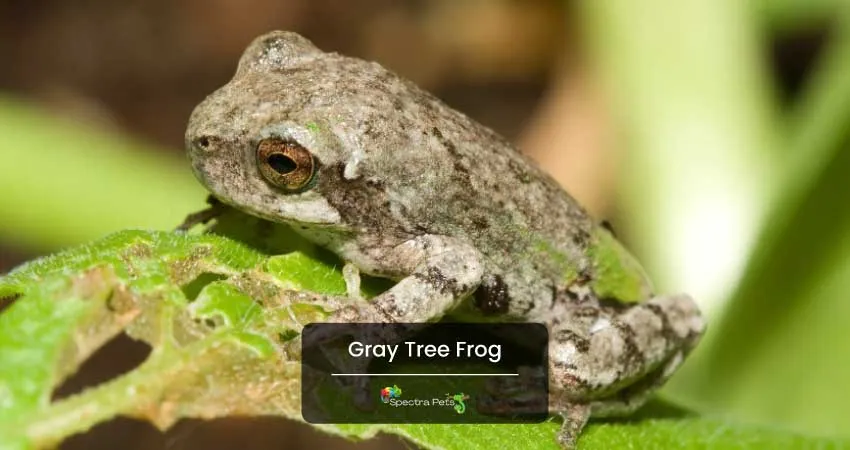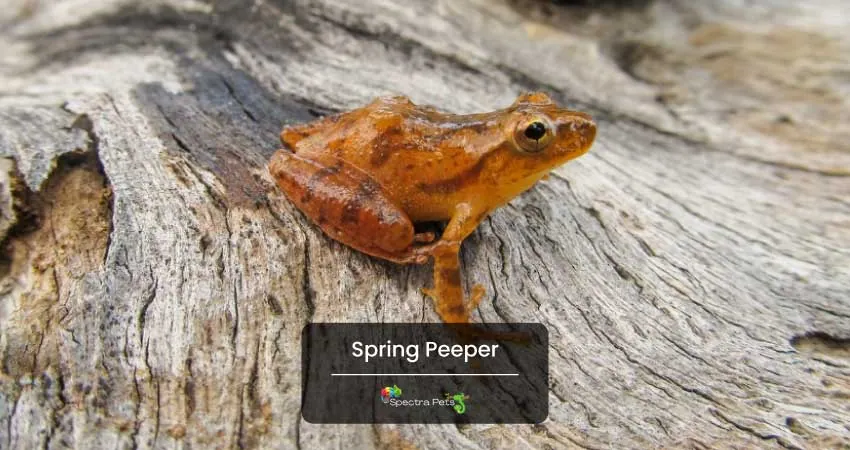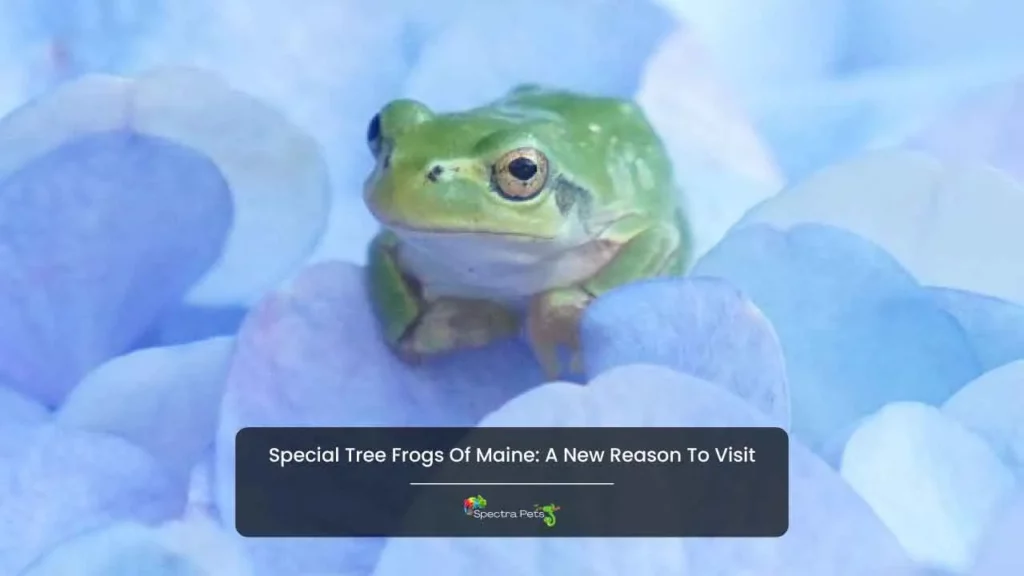You might have visited Maine for it’s vast river streams and lobsters, but have you ever thought of going on a vacation there to look at some unique tree frogs? I bet you haven’t.
If you never thought of Maine as the birthplace of a few tree frogs, then let me show you the two thriving species that’s been ruling the forest & swamp areas. They are Gray tree frogs and Spring peepers.
Here, I will highlight different characteristics of these two Maine tree frogs, such as their lifespans, skin colors, ranges, natural habitats, hibernation ability, diet, predators, mating season, maturity age, and sizes.
Without wasting any more moments, let’s see both of these frogs in detail.
1. Gray tree frog
Gray tree frog does pretty well & flourishes in the cold, mid-level summer, and snowy climate of the Maine state. Along with that, they are doing well in the wooded zone of the eastern side of the USA like Florida, Kansas, Texas, Ohio, etc.
It won’t be an unusual event for the native people of Maine to see them in their backyard. This Hylidae member is blessed to have the color-changing ability which helps them a lot to survive for a long time.
Moreover, these precious amphibians choose their habitat in varieties of locations like mountain streams, wooded zone nearby humid swamps, agricultural land, and forest.

It’s hard to tell the difference if you encounter them in two varieties of locations. When they live in any greeny vegetated zone, the skin shade turns green; when it takes a rest on a brown surface like leaf litter or bark, the shade turns brown.
On top of that, these little fellas are skilled climbers and they pass a long time residing high in the trees. The incredible average 7-9 years lifespan shows how good these frogs are at surviving.
As soon as the male & female hit sexual maturity, they don’t delay engaging in mating season. The breeding season remains from Spring-Summer. During this time, the male songsters try to grab the attention of females for breeding.
After mating, the mommy frog lays around 1800 eggs on leaves & aquatic plants. These eggs turn into squishy cute looking froglets after 2.5 months.
These vicious eaters enjoy a good amount of mites, plant lice, spiders, slugs, and various invertebrates. All these healthy diet consumption lead to a maximum of 2.25″ size in the adult stage.
Read Also: Are Gray Tree Frog Poisonous?
2. Spring peeper
This loud frog is a famous member of the Hylidae family that has a strong presence in many areas of the USA. Dwellers of Maine will see them in versatile skin color that includes tan, brown and reddish.
Plus, the species sometimes start their hunting in the early evening. But for the most part, when the sun goes down, they slowly start to get into the mood of food hunting.
The lifespan of this tiny frog is close to 3-4 years in the wild. During the adult stage, they can each have a maximum length of 1.5″.

Excellent climbing ability provides them tremendous support to evade the predator and take safe shelter on top of trees. And the sticky toe pad, small body size, and lightweight give the backup for climbing.
Speaking of the physical differences, the male & females have strong features. The female’s skin looks paler & the male has darker skin shades. These lovely amphibians reach sexual maturity within the first year and start mating activity in the April-June period.
When breeding activity is complete then the female frog would lay 1000+ eggs in a single season. Luckily a significant amount of eggs successfully become froglets that enter the local ecosystem.
As I told earlier, the weather of Maine includes snowy weather and the spring peeper frog has no problem with that. Due to their remarkable hibernation ability, they spend their entire winter season staying under the bark of trees or beneath tree logs.
Plus, the natural habitat of these unique species includes moist areas, wooded zone, grassland, and lowland which are very close to shallow wetlands, ponds, or lakes. Though they hunt a lot but not poisonous at all.
Moreover, different animals like salamanders, fish, birds of prey, and large size amphibians are the main predator of this tree frog. And they live on eating spiders, flies, beetles, etc.
What is the Natural Habitat of Maine’s Tree Frogs?
Maine’s tree frogs, despite their varied personalities, share a common love for woodlands and forests. They’re usually found clinging to trees, resting on leaves, or sometimes just making themselves comfortable in some rotten wood. Ah, the life of a frog!
Both the Gray Treefrog and Cope’s Gray Treefrog (a doppelganger of the Gray Treefrog) are pretty hardcore about their preference for wooded areas. A study by the Maine Department of Inland Fisheries and Wildlife found that these species particularly thrive in deciduous and mixed forests.

However, as the seasons turn and Jack Frost makes his appearance, our resilient tree frogs employ an “adapt or perish” strategy. They take cover in leaf litter and burrow into the soft, welcoming earth to hibernate. Come spring, they crawl out of their winter retreat, heralding the season with their harmonious calls.
There’s something about water that’s irresistible to these creatures. Be it ponds, marshes, or temporary pools formed by rainwater, these habitats provide the perfect nursery for their offspring. You can almost hear the relief in their calls when the spring rain finally drenches the thirsty earth.
What Adaptations Help Maine’s Tree Frogs Survive?
Now, let’s dig deeper and uncover the secrets of survival that these tree frogs hold. As any Mainer knows, the weather here is as unpredictable as a cat on catnip. How do our friends, the tree frogs, cope with it all?
Camouflage and Color Changes
Gray Treefrogs, true to their name, can alter their skin color from light gray to green to blend in with their surroundings. Imagine the convenience of changing your skin color according to the wallpaper!
Hibernation Techniques in Cold Weather
When winter comes knocking, these tree frogs turn to their personal ‘Winterfell.’ They hibernate by producing glycerol, a type of antifreeze, to protect their cells from freezing. No one does winter like a Maine tree frog!
Diet and Predatory Strategies
A tree frog’s menu mostly features a variety of insects. The Spring Peeper, for example, likes to dine on ants, beetles, and spiders. Who needs a fancy French menu, when the bugs in your backyard are just as crunchy?
What Role do Tree Frogs Play in Maine’s Ecosystem?
Small as they are, tree frogs play a big role in maintaining the ecological balance in Maine. Don’t let their size fool you; these creatures are like the hidden cogs and gears that keep the clock of nature ticking in harmony.
Impact on Insect Population Control
Tree frogs act as nature’s pest control. Their diet primarily consists of insects, making them a crucial part of controlling the bug population. Without them, we’d be knee-deep in creepy crawlies!
Role in the Food Chain: Predators and Prey
As predators, tree frogs keep the insect population in check. However, they are also prey to many larger animals. It’s the circle of life, and it moves us all (through despair and hope, through faith and love, until we find our place on the path unwinding – well, you know the tune!).
Indicators of Environmental Health
Like the canary in the coal mine, the presence and health of tree frogs often indicate the overall health of the environment. Scientists often refer to them as “bioindicators” because changes in their population can signal changes in the environment.
What Threats do Tree Frogs in Maine Face?
Despite their resilience, tree frogs in Maine are not immune to the dangers that threaten their survival. Let’s delve into some of the dark clouds looming over their existence.
Habitat Loss and Fragmentation
Expanding human activities, deforestation, and urban development have led to loss and fragmentation of their habitats. It’s like being evicted from your home with no place to go!
Climate Change and Global Warming Effects
Climate change and its myriad effects pose a significant threat to these cold-blooded creatures. Rising temperatures, altered precipitation patterns, and increased frequency of extreme weather events disrupt their breeding and hibernation cycles.
Pesticides and Pollution Impact
Chemical pesticides and pollution are another significant concern. A 2013 study published in Environmental Health Perspectives highlighted that even low levels of pesticides could be lethal to amphibians, including our beloved tree frogs.
What Conservation Efforts are in Place to Protect Maine’s Tree Frogs?
Don’t lose heart just yet! There are multiple efforts underway to ensure these symphonists of the forest continue to play their tunes.
Local and National Conservation Programs
Programs like the Maine Amphibian and Reptile Atlasing Project (MARAP) are working tirelessly to collect data and track the state’s amphibian populations, including tree frogs. Knowledge, after all, is the first step towards conservation!
Citizen Science Initiatives
Mainers can also join in the action through citizen science initiatives, like FrogWatch USA. Participants can contribute to conservation by monitoring local frog and toad populations and reporting their findings.
Role of Legislation and Regulatory Measures
On a broader scale, regulatory measures, such as the Clean Water Act and the Endangered Species Act, play an essential role in providing legal protection to these creatures and their habitats.
How Can Individuals Help in Conserving Tree Frogs in Maine?
If you’ve been nodding along, wondering how you can help our hoppy friends, you’re in luck! Here are some ways to contribute to their conservation.
Building Frog-friendly Backyard Habitats
One simple way to help is by creating a frog-friendly habitat in your own backyard. Building a small pond and maintaining a pesticide-free garden can attract frogs and provide a safe haven for them.
Participating in Citizen Science Projects
You can also lend a hand in scientific research by participating in citizen science projects. These initiatives rely on volunteers to gather data, which aids in conservation efforts.
Spreading Awareness and Education
Another powerful tool is education. By learning about these creatures and spreading awareness, we can inspire others to join the cause and create a ripple effect of conservation.
Read Also: Frogs in Maine
Final words
So, the next time you’re out on a spring evening in Maine, and you hear the symphony of the tree frogs serenading the night, take a moment. Consider the intricate web of life that these tiny creatures are a part of, and the small yet significant role they play in maintaining the balance of our ecosystems.
Our actions today will shape their world tomorrow. So let’s each do our part, ensuring that Maine’s chorus of tree frogs continues to fill the night with their music for generations to come.
